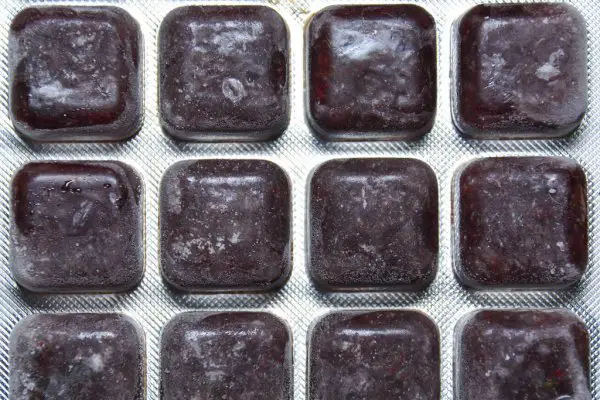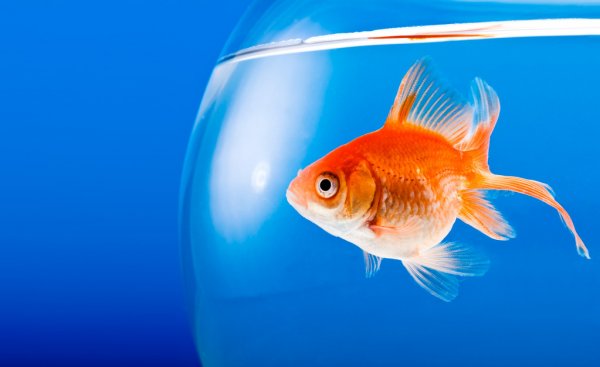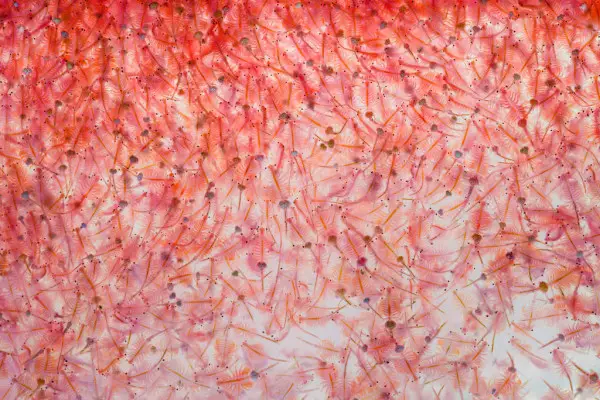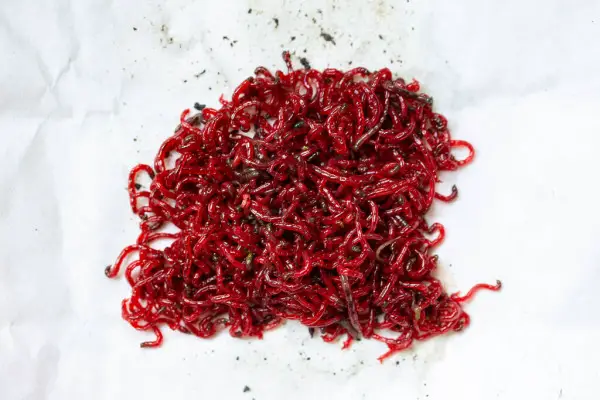Blood worms are a little icky and very squirmy! And they often find their way into the fresh and frozen aisle of local fish stores for aquarists looking to provide the very best goldfish food they can.
Since blood worms are a little different from goldfish flakes, you might be hoping to learn more about these bright red insect larvae. If you’re worried about feeding a goldfish bloodworms, then you’ve come to the right place!
What Are Bloodworms?
Can goldfish eat bloodworms? Well, when talking about bloodworms, it’s helpful to define terms. What exactly do we mean by bloodworms, anyway? As it turns out, there’s more to the story here.
“Bloodworms” are a common name that actually refers to two entirely different classes of invertebrates!
There are marine annelid worms in the genus Glycera that go by this name. Since they are annelid worms, they are actually closely related to both garden variety earthworms as well as the freshwater tubifex worms, which also show up in the aquarium trade as fish food.

Marine bloodworms get their name because they have bright red blood with hemoglobin, just like us humans. These blood worms are usually sold as bait for saltwater fishermen and are much too large for all but the biggest aquarium fish to eat. Many of them also bite using sharp fangs when grabbed – and a few even have venom to their bite! So feeding goldfish bloodworms from the ocean is not recommended.
The second group, the kind you’re more interested in feeding to goldfish, aren’t actually worms at all! These are insects similar to mosquito larvae. Specifically, they are the young of midge flies in the family Chironomidae. As adults, these tiny flies live around bodies of water, but their larvae are aquatic.

These blood worms don’t bite when fully grown. So don’t worry about a goldfish not eating the live bloodworms you offer and ending up with “mosquitoes” in your house. Besides, goldfish find live bloodworms impossible to resist since they sit right near the water surface in order to breathe and are easy to see!
Types of Goldfish Bloodworms
Bloodworms typically come in three forms: live blood worms, frozen bloodworms, and freeze-dried bloodworms. Most pet stores will carry freeze-dried bloodworms right alongside flakes and pellets as a sort of treat for your fish. Goldfish, bettas, and other aquarium fish with large mouths have the least amount of trouble with these. But they can sometimes be a bit too “chewy” for tetras, livebearers, and other small fish with small mouths.
Frozen bloodworms can be found in most major retail pet stores and specialty aquarium stores. They usually come in either cube form, which can be dropped right into the tank or a thick sheet of frozen worms.

Live bloodworms are the least common kind to find. Specialty aquarium fish stores are the only place you’re going to find these. If you live near a pond, you might also see some wild bloodworms. But I’d avoid feeding these to goldfish because you don’t know what sort of pollution, parasites, or bacteria they may have picked up in their environment. Frozen and freeze-dried bloodworms are captive-raised for the pet trade and are much cleaner.
Frozen or freeze-dried blood worms are much more easily found than live bloodworms. Live food is harder to transport and care for. You do lose some nutritional value by freezing them – and even more by freeze-drying blood worms. But they are still excellent additions to a goldfish’s stable diet.
Are Frozen Bloodworms Bad for Goldfish?
Not at all; in fact, a nutritious diet for goldfish includes invertebrate protein on a regular basis! Bloodworms are rich in iron and protein, which goldfish need. And the indigestible exoskeleton, made of chitin, helps waste move freely through the gut to be expelled.
Do Goldfish Eat Frozen Bloodworms?

They will eat them with relish! Just be careful in how you feed them. Live bloodworms are much easier since there is no thawing required.
When first added to your tank, the bloodworms will be frozen solid. But as they begin to thaw, individual worms will begin to fall into the water column, to be snapped up by your goldfish! That said, avoid offering small pieces of frozen bloodworms to large goldfish. If they swallow the frozen chunk whole, the ice can cause freezing of the insides as it thaws, which is very damaging to fish.
If you want to be entirely safe, then take a moment to thaw your blood worms in a small amount of aquarium water. Once the frozen mass falls apart, you can then feed bloodworms to your goldfish! Don’t use tap water to thaw out your blood worms since it contains chlorine and chloramine, which are toxic to fish.
How Many Bloodworms Should I Offer?
This depends mostly on the size of your fish and how hungry they are! By now, you should have a good idea of how much food your goldfish normally eats. Just be careful not to offer too many all at once.
Just like dry food, we don’t want any uneaten food to fall between grains of gravel, behind rocks, and in other places where it will start to rot. Remove uneaten food if your goldfish seems full and there is too much lying around the tank. Otherwise, you may see a spike in ammonia levels, which is harmful to all aquatic animals.
What Else Should You Feed Your Goldfish?
Many animals prefer only to eat meat (carnivores) or eat plants (herbivores). But goldfish are one of the few aquarium fish that are true omnivores rather than being primarily herbivores or carnivores. This means that a goldfish’s diet includes both animal and plant matter. Bloodworms are a great addition to a balanced diet because insect larvae are exactly the kind of food that they would normally find in the wild.
Still, goldfish also feed on things like aquatic plants, leafy greens, worms, snails, and fish eggs. Anything they can find along the bottom of a river or pond.
Remember to always feed your goldfish a varied diet. Since you probably don’t have many fish eggs or snails on hand to feed the try offering shelled peas and soft aquatic live plants alongside live foods like tubifex worms. If your goldfish eat flakes, you can continue to keep feeding those; just be aware that goldfish can eat nearly anything and should be fed more veggies and fresh prey!
Brine Shrimp and Other Frozen Fish Food

The next time you head to the pet store for goldfish food, take a walk through the frozen food section of the fish store. You’ll likely find not only frozen blood worms but other items like brine shrimp, daphnia, copepods, and even beef heart!
All of these are convenient ways to feed your goldfish while adding diversity to their omnivorous menu. Keeping fresh foods on hand to feed goldfish can be an issue since these items all spoil quickly.
I prefer frozen over freeze-dried food because the freeze-drying process causes many essential proteins, vitamins, and minerals to be destroyed. After all, it’s the denaturing of these agents and the removal of water that prevents bacteria from rotting these food sources. Adding them back to the water helps restore their nutritional profile, but they aren’t nearly as healthy as they once were.
What About Live Goldfish Food?
Goldfish of all kinds, from common to fancy goldfish, absolutely love live foods! They wiggle and dart about the fish tank, which spurs a predatory response from your aquarium fish. Live food does have a few disadvantages; namely, they need to be kept alive if you aren’t feeding them right away.
Live food can also carry parasites and bacteria that then get passed onto the fish that eats them. Bloodworms are one of the cleaner sources of live fish food, so this isn’t much of an issue. But some other live foods, especially tubifex worms, can be quite dirty and should be fed sparingly.
Wrapping Things Up

While dry goldfish food can form the bulk of their diet, as omnivores, they crave loads of variety in a healthy diet. That means not just plants but animal matter as well. Bloodworms are one of the cheapest and nutritious ways to get goldfish the fresh animal protein they need!
They also come in several convenient forms, including freeze-dried and frozen, so you aren’t dealing with squirming insect larvae. Try offering your goldfish bloodworms sometime and watch them greedily enjoy the treat!
Related Frequently Asked Questions:
- Can goldfish eat rice?
- Can goldfish eat worms?
- Can goldfish eat mealworms?
- Can goldfish eat algae wafers?
- Can goldfish eat bread?
- Can I feed my goldfish human food?

